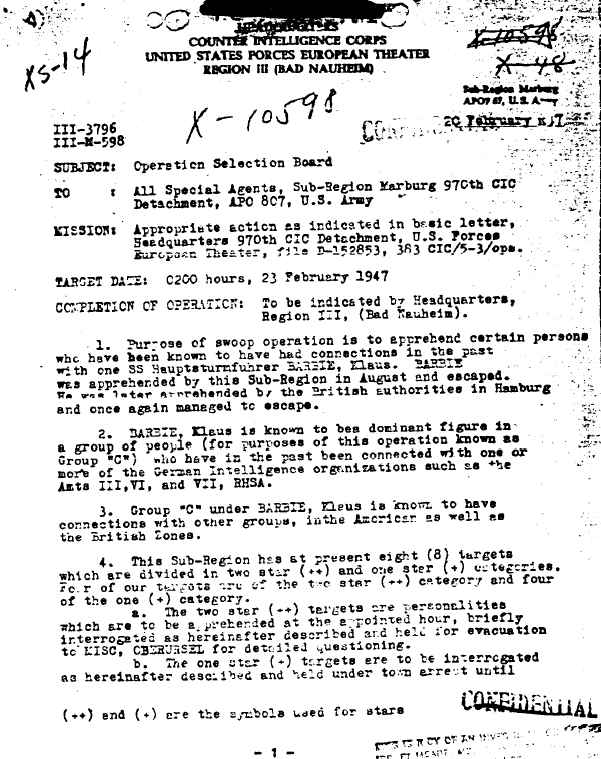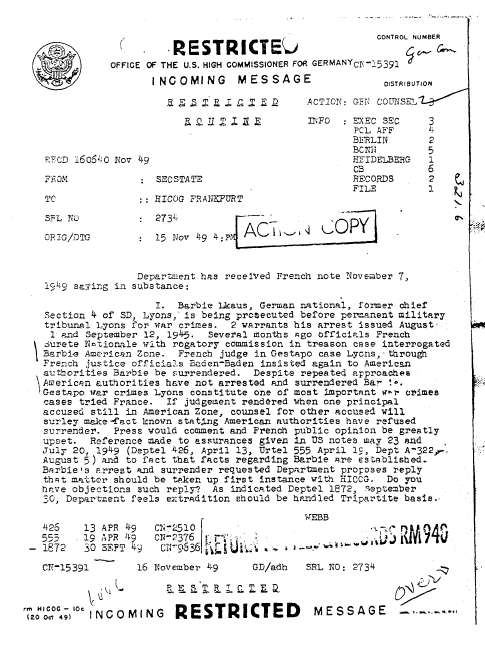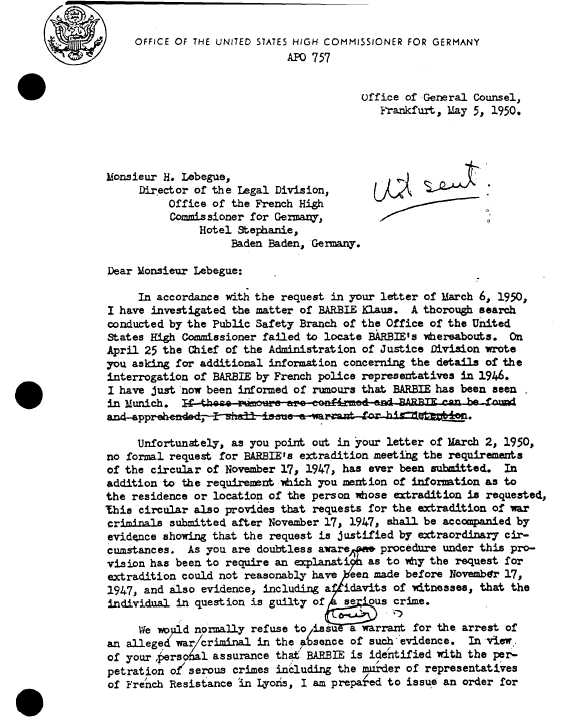|
Klaus Barbie
Department of Justice - FBI - Department of State
CIA - Counter Intelligence Corps Files
955 pages of DOJ, FBI, Department of State, CIA, and CIC files covering Klaus Barbie..
Klaus Barbie, the Nazi war criminal and drug trafficker, also known as the Butcher of Lyon, was born on October 25, 1913 in Godesberg in the Rhineland. In 1933, Hitler became chancellor of Germany and Barbie joined the Hitler Youth. Beginning in February 1935, Barbie served as personal adjutant to the head of the local Nazi party office in Trier. It was at this time, according to his handwritten autobiography in his SS personnel file, that Barbie began to work with the SS, Sicherheitsdienst (literally, security service), the Nazi Party intelligence and espionage agency. Barbie officially joined the SS and SD (Gestapo, secret police) on September 26, 1935.
On June 20, 1940, the Germans captured Lyon, and two days later the defeated French signed an armistice that divided the country into two zones: the north, occupied by the Germans, and the south (including Lyon), administered by a French collaborationist government at Vichy. In November 1942, however, the southern zone was occupied by the Germans after the successful Allied invasion of North Africa. According to his personnel file, and consistent with his career to that point, Barbie was assigned to Lyon as chief of Section VI, Intelligence. Barbie set up his office in the Hotel Terminus.
Barbie's arrival in Lyon in November 1942 coincided with a dramatic increase in the ranks of the French Resistance. In 1943 he moved to offices in the Ecole de Sant Militaire and had torture chambers constructed. The difficulty of combating the resistance in Lyon grew as the German military began to lose ground, the ranks of the resistance grew. Despite this, Barbie could boast of considerable successes.
In a short period in the summer of 1943, he was responsible, in part, for the arrest of General Delestraint, the commander of the Armee Secrete, and of Jean Moulin, the head of the Resistance, as well as several key resistance leaders. On June 7, 1943, Barbie captured French Resistance member Rene Hardy. Barbie was able to extract enough information to catch Jean Moulin, Pierre Brossolette and Charles Delestraint. Both Moulin and Brossolette were tortured to death. Delestraint was sent to Dachau where he was killed near the close of World War II. Rene Hardy was put on trial for treason in 1947. So effective were the actions in Lyon in the summer of 1943, that the French Resistence wing located in Lyon decided to move to Paris, which it considered safer than Lyon.
Before Allied troops were able to liberate Lyon in September 1944, hundreds of French nationals who had first hand knowledge of his crimes were killed. Twenty double-agents who had infiltrated French Resistance were but to death. Barbie returned to Germany, where after the war he was recruited by the United States Counter-Intelligence Corps (CIC). It has been estimated that below his command 7,500 people were deported, and 4,342 were murdered.
From 1945 to 1955, he was protected and employed by British and then American intelligence agents. In 1952 and 1954, military tribunals in Lyon found Barbie guilty of torture, executions, deportations, and looting. Barbie was sentenced to death in absentia. With American help Barbie moved to Bolivia in 1955.
When French agents were on the trail of Barbie, the CIC contacted Dr. Krunoslav Draganovic, a Croatian priest who ran a "ratline" which helped hundreds of Nazi SS officers escape from Europe. Father Draganovic arranged papers and transportation for Barbie to flee from Germany to Italy and then to Argentina and Bolivia.
In 1971, Nazi hunters located Barbie in Bolivia, where he had become a drug lord. In 1980, while in Bolivia using the alias Klaus Altmann, Barbie took part in the "Cocaine Coup." Luis Garcia Meza Tejada gained power in 1980 as the result of the "Cocaine Coup" on July 17, 1980, with the backing of Barbie and Italian terrorist Stefano Delle Chiaie. His government ended in 1981. His regime became internationally known for its drug trafficking activities. He brutally repressed the opposition and some 1,000 people are estimated to have been killed by the Bolivian army and security forces during his period in office. The former president was sentenced to 30 years in prison for human rights violations.
In 1983, a Bolivian government was in power that was willing to deport Barbie to France. On May 11, 1987, Barbie went on trial in Lyon. On July 4, 1987, Barbie was sentenced to life for crimes against humanity. Klaus Barbie died of leukemia in prison on September 25, 1991.
DOJ FILES
808 pages of Department of Justice files.
In 1983, a 240-page report of the results of a Department of Justice investigation, titled, "Klaus Barbie and the United States Government: A Report to the Assistant Attorney General, Criminal Division," was released. This was the U.S. government's first examination of the role that the Counter Intelligence Corps played in postwar Europe. While Allan A. Ryan, director of the Justice Department's Office of Special Investigations (OSI) and the author of the report, focused primarily on the Army's relationship with Barbie, he also uncovered the extent of the CIC's rat line and its dealings with Father Dragonovic. The Barbie Report and the declassified documents in the Appendix provide a valuable account of CIC's activities in Germany and Austria.
The report on Klaus Barbie found that U.S. Army Counter-Intelligence Corps officers had employed him, protected him from extradition to France where he was wanted for war crimes, and organized his escape to South America. The report commented that often there is a need for information that necessitates dealing with criminals, former enemies, and other undesirable persons. Lacking an intelligence network targeted against its former ally, the Soviet Union, U.S. intelligence units turned to European anti-Communist resources to fill information gaps. These resources included former German and East European intelligence operatives and East European emigre political groups. Among them were Nazis (including Gestapo and SS members) and members of East European Fascist organizations. They were considered invaluable as informants.
Subjects and Topics covered in the report include:
KLAUS BARBIE: Early Career, Barbie in France, Sources of Information, The Personnel File. Operational Record, Postwar Evidence, Barbie in Lyon, 1942-1943, Barbie in Lyon, 1943-1944. The Listing of Barbie in CROWCASS.
BARBIE'S RECRUITMENT AND USE BY THE U.S. ARMY, 1947-1949: Introduction to the United States Army. Counter Intelligence Corps. CIC Operation Selection Board. Barbie is Targeted for Arrest. Barbie Evades the Selection Board Dragnet. Recruitment and Use of Barbie by CIC. Arrest and Interrogation of Barbie, Barbie's Renewed Use, 1948-1949. Reconstruction of the Merk Net. Dissolution of the Merk Net. Interrogation of Barbie by French Intelligence.
FRANCE REQUESTS EXTRADITION: Public Accusations of Torture Against Barbie and CIC's Response. French Requests to U.S. High Commissioner for Germany to Obtain Barbie's Surrender. Initial Inquiries by the French Through Official Channels, 1949-1950. The French Request for Extradition of Barbie. CIC's Decision that Barbie "Should Not Be Placed in the Hands of the French." Response by U.S. High Commissioner for Germany to the French Government. Discussion Between U.S. High Commissioner for Germany and EUCOM/CIC. CIC and U.S. High Commissioner for Germany Response to State's Approval of Extradition.
ESCAPE TO BOLIVIA: The Rat Line. Putting Barbie in the Rat Line. Barbie's Travels in the Rat Line. The Question of CIA Involvement with Barbie Through 1951.
BARBIE IN BOLIVIA: The Absence of Any Relationship with the CIA. The Army's Interest in "Reactivating" Barbie in 1965-1967. Barbie's Entries into the United States. INS' Notification to CIA of Altmann's Entries. State Department Response to 1972 Extradition Request. Allegations of Barbie's Involvement in Criminal Activities. Drug Trafficking. Weapons Trade.
CONCLUSIONS AND RECOMMENDATIONS: Recruitment and Use of Barbie, 1947-1949. CIC's Response to U.S. High Commissioner for Germany. The Escape of Barbie Through the Rat Line. Use of the Rat Line in Cases Other Than Barbie's. Use of the Rat Line in Barbie's Case.
Documents cited in this report are contained in a separate appendix to the report.
Documents Related to Klaus Barbie and the United States Government
"Klaus Barbie and the United States Government Exhibits to the Report to the Attorney General of the United States," a 568 page companion volume to the report above. Documents in this volume date from 1947 to 1970. Allan A. Ryan, Jr., then Special Assistant to the Assistant Attorney General, wrote that every document he believed to be relevant to Barbie's relationship with the United States government is contained in the appendix. Includes documents from Counter Intelligence Corps, Office of U.S. High Commissioner for Germany, Department of State, and French agencies. The documents contained in this volume are cited in the report.
Documents of interest include:
A CIC report states that beginning in late 1945 or early 1946, a group of former SS officers still at large formed a clandestine "resistance" organization in occupied Germany. Rather than resorting to violence or terrorism, however, the leaders of this organization planned to approach occupation authorities with a proposal: to give to these men the responsibility of German administration in the British and American zones, thus ensuring a strong, experienced corps of post-war leaders, loyal to Germany and opposed to Communism.
A CIC memo contains details of Barbie's 1946 escape from custody. A memo describes Barbie's alleged activities in the 1946-47 period, including his travels in Germany, his contacts with various Germans and his alleged involvement in a jewel theft and the black market. A copy of an Allied Control Authority Central Registry of War Criminal and Security Suspects want list naming Klaus Barbie as wanted by France for murder. Information from the French Embassy and the Department of State, showing that the French persisted in their attempts to secure Barbie's surrender.
A memo shows that on June 19, 1950 the French Embassy in Washington provided the State Department with a dossier on Barbie's wartime actions, and expressed its hope that this latest information would facilitate the search for Barbie, in which "the French authorities earnestly hope to receive the cooperation of the American occupation authorities in Germany." A CIC memo shows that in December 1950, the 66th CIC Headquarters learned about the rat line operation. It states, "The 430th CIC Detachment has been operating what they term a 'Ratline' evacuation system to Central and South America without serious repercussions during the past three years. At the cost of approximately $1,000 each adult, 430th CIC is transferring evacuees to Italy where they are provided with legal documentation obtained through devious means there."
A CIC memo accounts the arrangements made for a final visit by Barbie's mother to see him before he left for South America. Copies of forged travel documents secured for Barbie's escape.
GAO REPORT
A 52-page, 1985 Government Accounting Office report titled, "Nazis And Axis Collaborators Were Used To Further U.S. Anti-Communist Objectives In Europe--Some Immigrated To The United States."
In May 1978, the GAO released a report, "Widespread Conspiracy To Obstruct Probes of Alleged Nazi War Criminals Not Supported by Available Evidence--Controversy May Continue."
The Nazi war criminal investigations took an unexpected turn in May 1982, when John Loftus, a former Department of Justice Office of Special Investigations attorney, announced on CBS-TV's 60 Minutes, that numerous branches of the US Government, including the Army, the FBI, the CIA, and the State Department, had employed Nazis and brought them to America after the war. Furthermore, Loftus charged that these same agencies had refused to support the GAO's 1977-78 investigation. These allegations sparked an immediate response on Capitol Hill and generated considerable media attention.
This led to a new GAO investigation that took another three years and unearthed thousands of documents from numerous agencies. This time, the Central Intelligence Agency granted the GAO investigators full access to its records in an effort to avoid the controversy that marred the first GAO examination.
In the summer of 1985, the GAO released its second report. After years of research through 150,000 files and interviewing numerous surviving American intelligence officers, the GAO concluded that "US intelligence used anti-Communist resources that had immediate intelligence potential." These "resources" included former Nazi intelligence personnel and collaborators. The GAO investigated some 114 individuals and provided detailed summaries on twelve.
FBI FILES
85 pages of FBI files dating from 1972 to 1987. Files contain approximately 43 discernable memos. Reports tell of 1972 Bolivian press reports that Klaus Altmann is actually Klaus Barbie. Mostly contains memos concerning the 1983 United States General Accounting Office and the Department of Justice's Office of Special Investigations, investigations of Barbie and possible U.S. assistance to Nazi war criminals.
CIA FILES
A four page 1983 memo summarizes the type of information the CIA has in its files concerning Klaus Barbie.
An eight page 1997 CIA Studies in Intelligence article titled, "CIA's Support to the Nazi War Criminal Investigations."
The disc contains a text transcript of all recognizable text embedded into the graphic image of each page of each document, creating a searchable finding aid. Text searches can be done across all files on the disc. |


